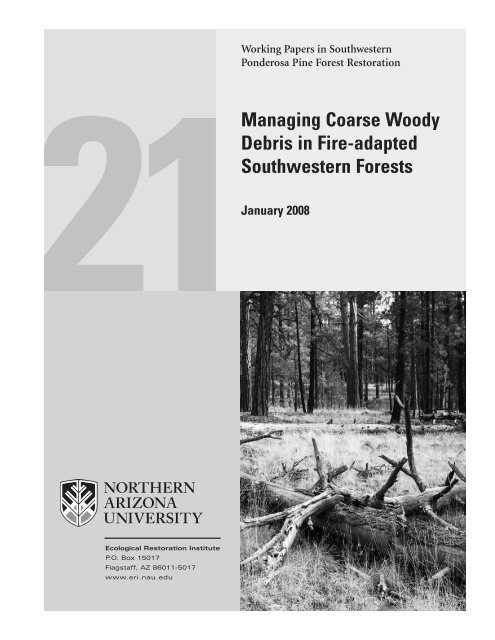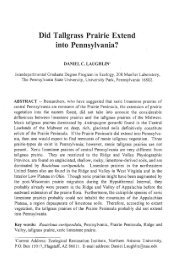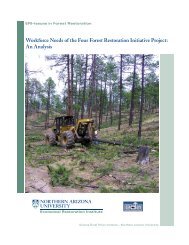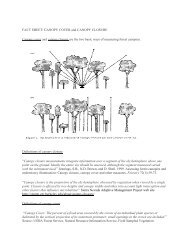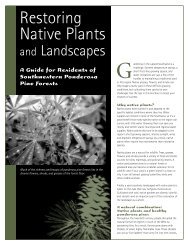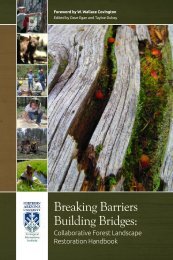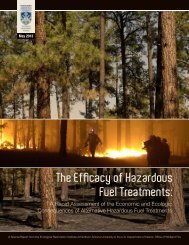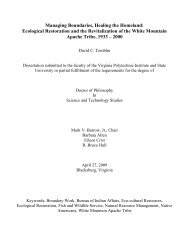Managing Coarse Woody Debris in Fire-adapted Southwestern ...
Managing Coarse Woody Debris in Fire-adapted Southwestern ...
Managing Coarse Woody Debris in Fire-adapted Southwestern ...
Create successful ePaper yourself
Turn your PDF publications into a flip-book with our unique Google optimized e-Paper software.
Work<strong>in</strong>g Papers <strong>in</strong> <strong>Southwestern</strong><br />
Ponderosa P<strong>in</strong>e Forest Restoration<br />
21January 2008<br />
<strong>Manag<strong>in</strong>g</strong> <strong>Coarse</strong> <strong>Woody</strong><br />
<strong>Debris</strong> <strong>in</strong> <strong>Fire</strong>-<strong>adapted</strong><br />
<strong>Southwestern</strong> Forests<br />
Ecological Restoration Institute<br />
P.O. Box 15017<br />
Flagstaff, AZ 86011-5017<br />
www.eri.nau.edu
Work<strong>in</strong>g Papers <strong>in</strong> <strong>Southwestern</strong> Ponderosa P<strong>in</strong>e Forest Restoration<br />
Ecological restoration is a practice that seeks to heal degraded ecosystems by reestablish<strong>in</strong>g native<br />
species, structural characteristics, and ecological processes. The Society for Ecological Restoration<br />
International def<strong>in</strong>es ecological restoration as “an <strong>in</strong>tentional activity that <strong>in</strong>itiates or accelerates<br />
the recovery of an ecosystem with respect to its health, <strong>in</strong>tegrity and susta<strong>in</strong>ability….Restoration<br />
attempts to return an ecosystem to its historic trajectory” (Society for Ecological Restoration<br />
International Science & Policy Work<strong>in</strong>g Group 2004).<br />
In the southwestern United States, most ponderosa p<strong>in</strong>e forests have been degraded dur<strong>in</strong>g the last<br />
150 years. Many ponderosa p<strong>in</strong>e areas are now dom<strong>in</strong>ated by dense thickets of small trees, and<br />
lack their once diverse understory of grasses, sedges, and forbs. Forests <strong>in</strong> this condition are highly<br />
susceptible to damag<strong>in</strong>g, stand-replac<strong>in</strong>g fires and <strong>in</strong>creased <strong>in</strong>sect and disease epidemics.<br />
Restoration of these forests centers on re<strong>in</strong>troduc<strong>in</strong>g frequent, low-<strong>in</strong>tensity surface fires—often<br />
after th<strong>in</strong>n<strong>in</strong>g dense stands—and reestablish<strong>in</strong>g productive understory plant communities.<br />
The Ecological Restoration Institute at Northern Arizona University is a pioneer <strong>in</strong> research<strong>in</strong>g,<br />
implement<strong>in</strong>g, and monitor<strong>in</strong>g ecological restoration of southwestern ponderosa p<strong>in</strong>e forests. By<br />
allow<strong>in</strong>g natural processes, such as fire, to resume self-susta<strong>in</strong><strong>in</strong>g patterns, we hope to reestablish<br />
healthy forests that provide ecosystem services, wildlife habitat, and recreational opportunities.<br />
The ERI Work<strong>in</strong>g Papers series presents f<strong>in</strong>d<strong>in</strong>gs and management recommendations from<br />
research and observations by the ERI and its partner organizations. While the ERI staff recognizes<br />
that every restoration project needs to be site specific, we feel that the <strong>in</strong>formation provided <strong>in</strong> the<br />
Work<strong>in</strong>g Papers may help restoration practitioners elsewhere.<br />
This publication would not have been possible without fund<strong>in</strong>g from the USDA Forest Service.<br />
The views and conclusions conta<strong>in</strong>ed <strong>in</strong> this document are those of the authors and should not be<br />
<strong>in</strong>terpreted as represent<strong>in</strong>g the op<strong>in</strong>ions or policies of the United States Government. Mention of<br />
trade names or commercial products does not constitute their endorsement by the United States<br />
Government.<br />
Cover: Several classes of coarse woody debris at Fort Valley Experimental Forest near Flagstaff, Arizona.<br />
Photo by Dave Eganc
Introduction<br />
<strong>Fire</strong>-<strong>adapted</strong> forested ecosystems <strong>in</strong> the Southwest evolved<br />
with a cont<strong>in</strong>ual flux of downed woody material—a structural<br />
component that is considered essential to a properly<br />
function<strong>in</strong>g forest ecosystem. The creation and accumulation<br />
of downed woody material depends on forest type, tree<br />
species, stage of succession/decay, the amount of <strong>in</strong>sect and<br />
disease activity, climate, fire return <strong>in</strong>tervals, w<strong>in</strong>dthrow, and<br />
management activities. In general, more downed woody<br />
material accumulates <strong>in</strong> forests with long fire return <strong>in</strong>tervals<br />
(subalp<strong>in</strong>e, mixed conifer, p<strong>in</strong>yon-juniper woodlands) than <strong>in</strong><br />
forests with short fire return <strong>in</strong>tervals, such as ponderosa p<strong>in</strong>e.<br />
While early foresters saw downed woody material as waste, a<br />
potential source of <strong>in</strong>sect and disease problems or a wildfire<br />
hazard, today’s foresters and researchers have identified the<br />
large-size component of downed woody material––coarse<br />
woody debris (CWD)––for its vital role <strong>in</strong> the ma<strong>in</strong>tenance of<br />
long-term site productivity, site protection, and wildlife<br />
habitat <strong>in</strong> fire-<strong>adapted</strong> forested ecosystems. Many studies<br />
(Harvey et al. 1979, 1980, 1987, 1988; Graham et al. 1994;<br />
Brown et al. 2003, Cram et al. 2007) report that CWD is<br />
important for develop<strong>in</strong>g nitrogen-fix<strong>in</strong>g bacteria and<br />
ectomycorrhizae, and for protect<strong>in</strong>g the soil surface from<br />
water erosion. Harvey et al. (1987) noted that decay<strong>in</strong>g wood<br />
and humus supply organic matter across the forested<br />
landscape—material that not only serves as a growth medium<br />
for seedl<strong>in</strong>gs but plays an <strong>in</strong>tegral part <strong>in</strong> support<strong>in</strong>g ongo<strong>in</strong>g<br />
tree growth. Brown et al. (2003), Carey and Johnson (1995),<br />
and Patton (personal communication) po<strong>in</strong>t out the<br />
importance of CWD to the life cycles of forest <strong>in</strong>sects, reptiles,<br />
mammals, and birds.<br />
Published research by Graham et al. (1994) recommends<br />
vary<strong>in</strong>g amounts of CWD depend<strong>in</strong>g on the type of forest<br />
ecosystem. However, research and management<br />
recommendations are lack<strong>in</strong>g with regards to the spatial<br />
distribution and amount of CWD by size class as well as the<br />
different CWD decomposition states needed for ma<strong>in</strong>ta<strong>in</strong><strong>in</strong>g<br />
and improv<strong>in</strong>g site productivity, soil quality and wildlife<br />
habitat (Bunnell et al. 2002), and for the safe use of natural or<br />
prescribed fire.<br />
One key assumption that underlies this discussion is that the<br />
site has been restored—that is, after treatment, a major<br />
portion of the project area is with<strong>in</strong> its natural range of<br />
variability for tree density, the natural open<strong>in</strong>gs are restored,<br />
the pre-European settlement fire regime is re-established, and<br />
the soils are function<strong>in</strong>g properly. Without the benefit of lower<br />
trees per acre, and the value that a more open forest structure<br />
has <strong>in</strong> terms of br<strong>in</strong>g<strong>in</strong>g the site closer to its historic fire<br />
regime, wildfires will be very difficult to control even when<br />
CWD is managed with<strong>in</strong> the scope of the recommendations<br />
derived from Graham et al. (1994) and found <strong>in</strong> the Region 3<br />
Supplement to the Soil and Water Management Handbook<br />
(USDA Forest Service Region 3 1999).<br />
Def<strong>in</strong><strong>in</strong>g <strong>Coarse</strong> <strong>Woody</strong> <strong>Debris</strong><br />
<strong>Coarse</strong> woody debris consists of dead fallen logs, stumps, and<br />
limbs that are at least 3 <strong>in</strong>ches <strong>in</strong> diameter at the po<strong>in</strong>t where<br />
they are sampled (Harmon et al. 1986, Brown et al. 2003).<br />
Stand<strong>in</strong>g snags and upright stumps are not considered CWD<br />
(USDA Forest Service 2004, U.S. Forest Service Region 3<br />
Supplement 2509.18-99-1). Smaller material, <strong>in</strong>clud<strong>in</strong>g litter<br />
or small twigs less than 3 <strong>in</strong>ches <strong>in</strong> diameter (new residue with<br />
little or no decay), are def<strong>in</strong>ed as f<strong>in</strong>e woody debris (FWD)<br />
(USDA Forest Service Northern Research Station 2007). F<strong>in</strong>e<br />
fuels are beneficial to soil quality (primarily for stability) but<br />
may be considered a fire hazard unless they are properly<br />
managed to meet both soil- and fire-related objectives.<br />
<strong>Coarse</strong> woody debris is also dist<strong>in</strong>guished from FWD by the<br />
length of time it takes to dry. Whereas the moisture content of<br />
FWD reaches the same level as the moisture <strong>in</strong> the atmosphere<br />
relatively quickly (1-100 hours depend<strong>in</strong>g on its diameter),<br />
CWD is rated as 1,000+-hour fuels because it takes<br />
significantly longer to reach the same moisture content level as<br />
the atmosphere (Maser et al. 1979, USDA Forest Service<br />
Northern Research Station 2007).<br />
<strong>Coarse</strong> woody debris is classified <strong>in</strong>to five categories accord<strong>in</strong>g<br />
to its degree of decay with class 1 be<strong>in</strong>g the most sound and<br />
class 5 the most decayed (see Figure 1 and Table 1).<br />
1<br />
This need for additional research and land management<br />
recommendations regard<strong>in</strong>g CWD is especially important <strong>in</strong><br />
order to ma<strong>in</strong>ta<strong>in</strong> the levels of exist<strong>in</strong>g and future CWD<br />
necessary to preserve fundamental ecological functions (e.g.,<br />
site and soil productivity, wildlife habitat) <strong>in</strong> light of the<br />
<strong>in</strong>creas<strong>in</strong>g <strong>in</strong>terest <strong>in</strong>, and government support of, us<strong>in</strong>g large<br />
quantities of woody biomass to produce wood products and<br />
energy (Skog and Barbour 2006, Hubka 2007, U.S. Forest<br />
Products Lab 2007).<br />
In this ERI work<strong>in</strong>g paper, we provide <strong>in</strong>sights <strong>in</strong>to these and<br />
other questions about CWD.<br />
Ecological Restoration Institute<br />
Figure 1. The classification of stand<strong>in</strong>g snags and decompos<strong>in</strong>g<br />
logs. From Thomas et al. 1979<br />
<strong>Manag<strong>in</strong>g</strong> <strong>Coarse</strong> <strong>Woody</strong> <strong>Debris</strong> <strong>in</strong> <strong>Fire</strong>-<strong>adapted</strong> <strong>Southwestern</strong> Forests<br />
a
2<br />
Decay<br />
Class<br />
a<br />
Structural<br />
Integrity<br />
Wood Texture<br />
1 Sound Intact, no rot;<br />
conks on stem<br />
absent<br />
2 Heartwood<br />
sound,<br />
sapwood<br />
somewhat<br />
decayed<br />
3 Heartwood<br />
sound; log<br />
supports its<br />
weight<br />
4 Heartwood<br />
rotten; log does<br />
not support its<br />
own weight,<br />
but shape is<br />
ma<strong>in</strong>ta<strong>in</strong>ed<br />
5 No structural<br />
<strong>in</strong>tegrity; no<br />
longer<br />
ma<strong>in</strong>ta<strong>in</strong>s<br />
shape<br />
Mostly <strong>in</strong>tact;<br />
sapwood partly<br />
soft and start<strong>in</strong>g<br />
to decay; wood<br />
cannot be<br />
pulled apart by<br />
hand<br />
Large, hard<br />
pieces of<br />
sapwood can be<br />
pulled apart by<br />
hand<br />
Soft, small,<br />
blocky pieces,<br />
metal p<strong>in</strong> can<br />
push heartwood<br />
apart<br />
Soft, powdery<br />
when dry<br />
Wood<br />
Color<br />
Orig<strong>in</strong>al<br />
color<br />
Orig<strong>in</strong>al<br />
color<br />
Red-brown<br />
or orig<strong>in</strong>al<br />
color<br />
Red-brown<br />
or light<br />
brown<br />
Red-brown<br />
to dark<br />
brown<br />
Presence<br />
of<br />
Invad<strong>in</strong>g<br />
Roots<br />
Absent<br />
Absent<br />
Present <strong>in</strong><br />
sapwood<br />
only<br />
Present<br />
throughout<br />
log<br />
Present<br />
throughout<br />
log<br />
Condition of<br />
Branches/Twigs<br />
If branches present,<br />
f<strong>in</strong>e twigs still<br />
attached with tight<br />
bark<br />
If branches present,<br />
many f<strong>in</strong>e twigs<br />
gone; attached f<strong>in</strong>e<br />
twigs have peel<strong>in</strong>g<br />
bark<br />
Large branch stubs<br />
will not pull out<br />
Large branch stubs<br />
will pull out easily<br />
Branch stubs and<br />
pitch pockets have<br />
rotted away<br />
Table 1. 1. Decay classes classes of coarse of woody coarse debris woody (from debris. Waddell From 2002). Waddell 2002<br />
Importance of <strong>Coarse</strong> <strong>Woody</strong> <strong>Debris</strong>: Soils,<br />
Wildlife, and <strong>Fire</strong> Hazard<br />
Soils<br />
<strong>Coarse</strong> woody debris performs many physical, biological, and<br />
chemical functions <strong>in</strong> forest ecosystems. Physically, CWD<br />
protects the forest floor and m<strong>in</strong>eral soil from erosion and<br />
mechanical disturbances. Brown et al. (2003) report that<br />
CWD helps protect soils from erosion on steep slopes, and<br />
disrupts the flow of water near the ground reduc<strong>in</strong>g the<br />
erosive potential of water and prevent<strong>in</strong>g losses to soil<br />
productivity. <strong>Coarse</strong> woody debris also <strong>in</strong>terrupts airflow and<br />
provides shade, <strong>in</strong>sulat<strong>in</strong>g and protect<strong>in</strong>g new forest growth.<br />
When decay is advanced (log decomposition classes 3-5),<br />
CWD can hold large amounts of water, mak<strong>in</strong>g it an<br />
important source of moisture for vegetation dur<strong>in</strong>g dry<br />
periods (Graham et al. 1994).<br />
Graham et al. (1994) noted that the breakdown of CWD<br />
provides most of the nutrients that are recycled through the<br />
ecosystem--the most important be<strong>in</strong>g sulfur, phosphorous,<br />
and nitrogen. Microbial processes and the overall potential for<br />
soils to provide nutrients is tied directly to the presence and<br />
ma<strong>in</strong>tenance of soil organic matter, which is, ultimately, the<br />
breakdown product from CWD and other organic materials<br />
(Brown et al. 2003).<br />
Nitrogen has been identified as the most limit<strong>in</strong>g soil nutrient<br />
<strong>in</strong> southwestern forest soils (Selmants et al. 2003). Moreover,<br />
it is also well known that ma<strong>in</strong>ta<strong>in</strong><strong>in</strong>g adequate levels of<br />
organic matter, especially decayed wood, is important for<br />
ma<strong>in</strong>ta<strong>in</strong><strong>in</strong>g the microbes <strong>in</strong>volved <strong>in</strong> nitrogen fixation<br />
<strong>Manag<strong>in</strong>g</strong> <strong>Coarse</strong> <strong>Woody</strong> <strong>Debris</strong> <strong>in</strong> <strong>Fire</strong>-<strong>adapted</strong> <strong>Southwestern</strong> Forests<br />
(Brown et al. 2003). Harvey et al. (1980, 1987) noted that<br />
symbiotic nitrogen-fix<strong>in</strong>g plants are <strong>in</strong>frequent <strong>in</strong> most forest<br />
ecosystems and that non-symbiotic bacteria are widely<br />
distributed and have the most <strong>in</strong>fluence on nitrogen fixation.<br />
Decay<strong>in</strong>g woody material that is not yet <strong>in</strong>corporated <strong>in</strong>to the<br />
soil, such as CWD, provides the highest per unit weight,<br />
nitrogen-fix<strong>in</strong>g capacity of any material available on the forest<br />
floor (Harvey et al. 1979).<br />
Harvey et al. (1981) found that ectomycorrhizae—a type of<br />
fungus associated with p<strong>in</strong>e tree roots––have a strong positive<br />
relationship with soil organic materials. Graham and his<br />
colleagues (1994) recognized this relationship when<br />
develop<strong>in</strong>g their recommendations for the amount of CWD<br />
to leave after timber harvest<strong>in</strong>g. In general, they assumed that<br />
more organic matter would result <strong>in</strong> more ectomycorrhizae.<br />
However, they found that <strong>in</strong> drier forest types, such as<br />
<strong>Southwestern</strong> ponderosa p<strong>in</strong>e, the highest amounts of active<br />
ectomychorrhizal root tips occurred when the organic volume<br />
was relatively low—from 0-20 percent <strong>in</strong> ponderosa<br />
p<strong>in</strong>e/Gambel oak on basalt soils and from 21-30 percent <strong>in</strong><br />
ponderosa p<strong>in</strong>e/Arizona fescue on limestone soils. This<br />
f<strong>in</strong>d<strong>in</strong>g suggested to them that the amounts of CWD <strong>in</strong> these<br />
dry habitats should be relatively low compared to more mesic<br />
vegetation types: 5-10 tons/acre of CWD on limestone soils<br />
support<strong>in</strong>g ponderosa p<strong>in</strong>e/Gambel oak, and 7-13 tons/acre<br />
on basalt soils support<strong>in</strong>g ponderosa p<strong>in</strong>e/Arizona fescue.<br />
Recent studies that looked at the effects of forest restoration<br />
treatments on mycorrhizae (Korb et al. 2003, Griffiths et al.<br />
2005) revealed that, after th<strong>in</strong>n<strong>in</strong>g and burn<strong>in</strong>g,<br />
endomycorrhizae <strong>in</strong>creased significantly but there was little<br />
effect on the levels of ectomycorrhizae. This f<strong>in</strong>d<strong>in</strong>g suggests<br />
that once ectomycorrhizae are <strong>in</strong> the soil they tend to<br />
ma<strong>in</strong>ta<strong>in</strong> their populations, and that even m<strong>in</strong>imal levels of<br />
CWD may have little correlation to susta<strong>in</strong><strong>in</strong>g adequate<br />
amounts of ectomycorrhizae.<br />
Wildlife<br />
Wildlife benefit from the presence of CWD because downed<br />
woody material is important <strong>in</strong> the life cycles of a wide variety<br />
of animals from mites to mammals (Brown et al. 2003).<br />
Patton (unpublished manuscript 2007) found that many<br />
species of animals, <strong>in</strong>clud<strong>in</strong>g rabbits, snakes, lizards and small<br />
rodents, use the open<strong>in</strong>gs that result from decayed roots for<br />
tunnels and dens. <strong>Coarse</strong> woody debris adds another level of<br />
diversity with<strong>in</strong> forested ecosystems that can be beneficial for<br />
several species of chipmunks, ground squirrels, rabbits,<br />
turkeys, and ground-nest<strong>in</strong>g birds (Patton unpublished<br />
manuscript 2007).<br />
Payne and Bryant (1994) noted that larger logs have more<br />
wildlife potential than smaller logs. Carey and Johnson (1995)<br />
stated that while a multiplicity of environmental factors<br />
determ<strong>in</strong>e animal species abundances, two factors––CWD<br />
Ecological Restoration Institute
and prevalence of shrub cover--play primary roles. They<br />
concluded that CWD, especially large, stand<strong>in</strong>g or fallen dead<br />
trees, is not only an important habitat component for forest<br />
floor small mammals, it also provides critical habitat elements<br />
for birds and amphibians.<br />
Probably one of the most persuasive reasons for manag<strong>in</strong>g<br />
CWD for wildlife exists <strong>in</strong> the Reynolds et al. (1992) report<br />
about prey species for the northern goshawk. They listed the<br />
follow<strong>in</strong>g goshawk prey species and their relation to CWD:<br />
Chipmunks: Downed logs and woody debris are important<br />
for nest<strong>in</strong>g, lookout po<strong>in</strong>ts, shelter, escape cover, and<br />
travel corridors.<br />
Northern flicker: Downed logs and woody debris are<br />
sources of <strong>in</strong>sect food.<br />
Red squirrel: Snags and downed logs are essential with the<br />
smaller woody debris be<strong>in</strong>g of less value.<br />
Stellar’s jay: Downed logs and woody debris are used as<br />
habitats for <strong>in</strong>sect food.<br />
Tassel-eared squirrel: Downed logs and woody debris are<br />
crucial for food substrate and cover.<br />
Williamson’s sapsucker: Downed logs and woody debris are<br />
significant forag<strong>in</strong>g sites.<br />
Given their f<strong>in</strong>d<strong>in</strong>gs, Brown et al. (2003) concluded that a<br />
range of 5-20 tons per acre appeared reasonable <strong>in</strong> ponderosa<br />
p<strong>in</strong>e/dry mixed conifer, whereas a range of 10-30 tons per<br />
acre could be allowed <strong>in</strong> cool, subalp<strong>in</strong>e forest types without<br />
creat<strong>in</strong>g a high fire hazard (Figure 2). The current<br />
management recommendations for CWD for long-term forest<br />
health <strong>in</strong> U.S. Forest Service Region 3 are below these<br />
maximum amounts. Brown et al. (2003) also noted that<br />
higher load<strong>in</strong>gs of CWD are acceptable where larger pieces of<br />
CWD predom<strong>in</strong>ate, which is typically the case once a forest’s<br />
spatial pattern and structure are restored and frequent ground<br />
fire is re<strong>in</strong>troduced.<br />
Almost half of the important prey species identified by<br />
Reynolds and his colleagues are directly l<strong>in</strong>ked to CWD. Ward<br />
and Block (1995) listed these same species as key food sources<br />
for Mexican spotted owls, which <strong>in</strong>dicates the importance of<br />
ma<strong>in</strong>ta<strong>in</strong><strong>in</strong>g specific levels and sizes of CWD for susta<strong>in</strong><strong>in</strong>g<br />
populations of prey for these valuable birds.<br />
3<br />
<strong>Fire</strong> Hazard<br />
Small and large woody debris contribute differently to a site’s<br />
fire hazard (which I def<strong>in</strong>e as the potential fire behavior for a<br />
given fuel type and its resistance to control). For <strong>in</strong>stance, the<br />
<strong>in</strong>fluence of duff and cont<strong>in</strong>uous FWD on the spread rate and<br />
<strong>in</strong>tensity of surface fires is substantial (Brown et al. 2003). In<br />
contrast, models that predict the <strong>in</strong>fluence of CWD on the<br />
spread and <strong>in</strong>tensity of <strong>in</strong>itiat<strong>in</strong>g surface fires show that this<br />
size class of downed woody material has little <strong>in</strong>fluence on<br />
fire hazard, although CWD can contribute to the<br />
development of large fires and high fire severity (Brown et al.<br />
2003). This same study noted that if large woody fuel is<br />
decayed and broken up, its contribution is considerably<br />
greater to a large fire event––similar to fire <strong>in</strong> heavy slash.<br />
Graham et al. (2004) expla<strong>in</strong>ed why this is the case when they<br />
noted that decayed CWD (log decomposition classes 4 and 5)<br />
produces firebrands that can create numerous ignitions po<strong>in</strong>ts<br />
far from of the ma<strong>in</strong> fire. Rotten wood is also more receptive<br />
to ignition when sparks land on it. Brown et al. (2003) also<br />
noted that burn<strong>in</strong>g large CWD can negatively affect nearby<br />
soil surface horizons, caus<strong>in</strong>g, among other outcomes, an<br />
<strong>in</strong>crease <strong>in</strong> water repellency and a loss of soil nutrients and<br />
microorganisms.<br />
Ecological Restoration Institute<br />
Figure 2. Optimum ranges of CWD that provide both<br />
acceptable risks of fire hazard and desirable levels for soil<br />
productivity, soil protection, and wildlife habitat. Dotted l<strong>in</strong>es<br />
<strong>in</strong>dicate a range that meets all or most resource needs. Chart<br />
A shows the range for warm, dry forest types, while Chart B<br />
displays the range for cool and lower subalp<strong>in</strong>e forest types.<br />
From Brown et al. 2003<br />
Exist<strong>in</strong>g Forest Service Management<br />
Recommendations<br />
The Forest Service <strong>Southwestern</strong> Region (Region 3) identifies<br />
CWD as a critical component for susta<strong>in</strong><strong>in</strong>g ecosystem<br />
functions (USDA Forest Service 1999). Region 3 recommends<br />
that 5-10 tons/acre of CWD rema<strong>in</strong> on-site <strong>in</strong> ponderosa<br />
p<strong>in</strong>e/Gambel oak forest, 7-14 tons/acre of CWD <strong>in</strong> areas<br />
dom<strong>in</strong>ated by ponderosa p<strong>in</strong>e/Arizona fescue, and 8-16<br />
tons/acre are <strong>in</strong> the mixed conifer forest. These CWD<br />
recommendations for ponderosa p<strong>in</strong>e were derived from<br />
research by Graham et al. (1994) and from an unpublished<br />
document by Graham et al. (1996) for mixed conifer.<br />
<strong>Manag<strong>in</strong>g</strong> <strong>Coarse</strong> <strong>Woody</strong> <strong>Debris</strong> <strong>in</strong> <strong>Fire</strong>-<strong>adapted</strong> <strong>Southwestern</strong> Forests<br />
a
4<br />
These recommendations, along with cont<strong>in</strong>ued susta<strong>in</strong>able<br />
management practices, will ensure that soil function is be<strong>in</strong>g<br />
susta<strong>in</strong>ed and the soil is function<strong>in</strong>g properly. If CWD<br />
requirements are less than what is recommended, a loss of soil<br />
function could occur.<br />
Additional direction for management of CWD, at least <strong>in</strong> U.S.<br />
Forest Service Region 3, can be found <strong>in</strong> Appendix C,<br />
Standards and Guidel<strong>in</strong>es <strong>in</strong> Selected Alternative G, which<br />
amended all exist<strong>in</strong>g forest plans <strong>in</strong> the region and clarified<br />
management direction for Mexican spotted owl and northern<br />
goshawk (USDA Forest Service 1996a). For example, the<br />
recommended guidel<strong>in</strong>es for northern goshawk <strong>in</strong> the<br />
forag<strong>in</strong>g areas are:<br />
• Ponderosa p<strong>in</strong>e: Leave at least two snags, three downed<br />
logs at least 12 <strong>in</strong>ches <strong>in</strong> diameter and at least 8 feet<br />
long, and 5-7 tons of CWD per acre.<br />
• Spruce-fir and mixed conifer: Leave at least three snags,<br />
five downed logs at least 12 <strong>in</strong>ches <strong>in</strong> diameter and at<br />
least 8 feet long, and 10-15 tons of CWD.<br />
While no specific Forest Service guidel<strong>in</strong>es exist for CWD <strong>in</strong><br />
p<strong>in</strong>yon-juniper ecosystems, Region 3 has developed m<strong>in</strong>imum<br />
structural attributes criteria for determ<strong>in</strong><strong>in</strong>g old growth <strong>in</strong><br />
such ecosystems. These guidel<strong>in</strong>es call for two 8- to 10-foot<br />
downed logs, with a diameter of 9-10 <strong>in</strong>ches, per acre (USDA<br />
Forest Service 1996a). Observations of p<strong>in</strong>yon-juniper<br />
ecosystems <strong>in</strong>dicate that some level of CWD needs to be left<br />
on-site for soil protection and to provide sites for the<br />
regeneration of native grasses and trees (Dave Huffman<br />
personnel communication, Gottfried and Severson 1994,<br />
Stoddard 2006, see Figure 3).<br />
Estimat<strong>in</strong>g the Amount of CWD Prior to<br />
Twentieth Century <strong>Fire</strong> Suppression<br />
Land managers <strong>in</strong> the frequent-fire regimes of the Southwest<br />
often ask: How much CWD existed <strong>in</strong> pre-European<br />
settlement southwestern forests? While the literature to<br />
support the follow<strong>in</strong>g idea is quite limited, it seems<br />
reasonable that frequent ground fires dur<strong>in</strong>g the pre-<br />
European settlement period resulted <strong>in</strong> relatively low amounts<br />
of CWD. Moir et al. (1997), for example, suggest that downed<br />
woody material was “sparse” prior to the exclusion of fire.<br />
Brown and his colleagues (2003) support this idea when they<br />
state that high-frequency, surface-fire disturbances that were<br />
typical <strong>in</strong> pre-European settlement warm/dry ponderosa p<strong>in</strong>e<br />
and Douglas fir ecosystems would result <strong>in</strong> less downed<br />
woody material, <strong>in</strong>clud<strong>in</strong>g CWD.<br />
However, unpublished research conducted by the Ecological<br />
Restoration Institute on several <strong>in</strong>frequently burned<br />
ponderosa p<strong>in</strong>e sites with<strong>in</strong> the Grand Canyon National Park<br />
<strong>in</strong>dicates that the average CWD ranged from a low of 6.7<br />
tons/acre reported for Ra<strong>in</strong>bow Po<strong>in</strong>t to a high of 19.3<br />
tons/acre at <strong>Fire</strong> Po<strong>in</strong>t. A site on Powell Plateau averaged 8.3<br />
tons per acre, with a low of 5.5 ton/acre and a high of 19.3<br />
tons/acre. The amount of FWD ranged from 1.5-2.6 tons/acre<br />
on Powell Plateau <strong>in</strong> the ponderosa p<strong>in</strong>e zone. The mixed<br />
conifer site on Powell Plateau averaged 41 tons/acre of CWD<br />
and 6 tons/acre of FWD. These results for CWD fall roughly<br />
with<strong>in</strong> the range of 5-15 tons/acre recommended by Graham<br />
et al. (1994) and by U.S. Forest Service Region 3 for CWD <strong>in</strong><br />
ponderosa p<strong>in</strong>e forests <strong>in</strong> Arizona.<br />
Prior to the exclusion of fire <strong>in</strong> the Southwest forest<br />
landscape, there was probably a wide range of CWD<br />
concentrations that surged and decl<strong>in</strong>ed on a cyclical basis<br />
depend<strong>in</strong>g on the frequency and <strong>in</strong>tensity of fire. However, <strong>in</strong><br />
general, it seems reasonable to assume that with the frequentfire<br />
regime typical of the pre-fire suppression era, there would<br />
have been more large, sound CWD (greater than 14 or 16<br />
<strong>in</strong>ches) and less FWD and rotten CWD (Cov<strong>in</strong>gton and<br />
Sackett 1984). Restor<strong>in</strong>g the spatial pattern and structure of<br />
today’s overstocked ponderosa p<strong>in</strong>e forests, and re<strong>in</strong>troduc<strong>in</strong>g<br />
fire will most likely result <strong>in</strong> similar concentrations of CWD<br />
and FWD after some period of time.<br />
a<br />
Figure 3. Over time, coarse woody debris may function as a<br />
“nucleus” around which woodlands develop after severe<br />
disturbance. This image shows (A) coarse wood left after a fire<br />
that probably occurred before 1900, (B) a juniper tree that has<br />
established and grown s<strong>in</strong>ce the fire, and (C) younger p<strong>in</strong>yon<br />
p<strong>in</strong>e trees that have established beneath the older juniper.<br />
Photo courtesy of Dave Huffman, ERI<br />
<strong>Manag<strong>in</strong>g</strong> <strong>Coarse</strong> <strong>Woody</strong> <strong>Debris</strong> <strong>in</strong> <strong>Fire</strong>-<strong>adapted</strong> <strong>Southwestern</strong> Forests<br />
Management Considerations<br />
Most of the ponderosa p<strong>in</strong>e and mixed conifer forests are<br />
significantly outside their natural range of variability with<br />
regards to trees per acre. This situation coupled with fuel<br />
load<strong>in</strong>gs, even when they are with<strong>in</strong> the range recommended<br />
by Graham et al. (1994), Brown et al. (2003) and Region 3 of<br />
the Forest Service, presents land managers with a potentially<br />
high fire hazard and calls for sound management of CWD.<br />
Ecological Restoration Institute
In the restoration of frequent-fire forest ecosystems, land<br />
managers need to make decisions about CWD based on their<br />
resource goals. If, for example, the goal is to reduce the<br />
potential for fire next to a human community (i.e., <strong>in</strong> a<br />
Wildland-Urban Interface), it might be appropriate to have<br />
CWD <strong>in</strong> amounts at the lowest end of the Forest Service’s<br />
recommended range (5 tons/acre), or possibly lower. On the<br />
other hand, if the goal is to ma<strong>in</strong>ta<strong>in</strong> and improve prey<br />
species for goshawks and other raptors, it might be best to<br />
ma<strong>in</strong>ta<strong>in</strong> a higher amount of CWD (20-25 tons/acre) <strong>in</strong> a<br />
variety of decay classes.<br />
From an ecological perspective, land managers should<br />
concentrate on reta<strong>in</strong><strong>in</strong>g a diversity of CWD classes that are<br />
distributed across the landscape (Harvey et al. 1987, Graham<br />
et al. 1994). Large CWD material, especially old logs that have<br />
some level of advanced decay, should receive special attention<br />
because of their importance for many species of animals.<br />
S<strong>in</strong>ce fire is an evolutionary process that shaped the forests of<br />
the Southwest, land managers can use it to manage CWD. As<br />
Harvey et al. (1987) po<strong>in</strong>ted out, moisture is so limit<strong>in</strong>g <strong>in</strong><br />
southwestern ponderosa p<strong>in</strong>e sites that it delays the biological<br />
breakdown of organic matter and leads to accumulations of<br />
CWD and other smaller materials. Under these conditions,<br />
fire has as much <strong>in</strong>fluence or more on the cycl<strong>in</strong>g of<br />
important soil nutrients, especially once the former open<strong>in</strong>gs<br />
have sufficient grass cover to carry a fire (DeBano et al. 1998,<br />
Brown et al. 2003).<br />
F<strong>in</strong>ally, land managers need to remember that adequate levels<br />
of CWD calls for ma<strong>in</strong>ta<strong>in</strong><strong>in</strong>g a sufficient population of<br />
snags, not only for immediate use by cavity-nest<strong>in</strong>g birds, bats<br />
and other animals, but to serve as future CWD (see ERI<br />
Work<strong>in</strong>g Paper 16 for <strong>in</strong>formation about snags).<br />
load<strong>in</strong>g by size class, percent sound CWD, basic stand<br />
<strong>in</strong>formation, and an assessment of fire behavior. Land<br />
managers <strong>in</strong> the Southwest who want to use photo series to<br />
estimate CWD, may be able to obta<strong>in</strong> a copy of Photo Series<br />
for Quantify<strong>in</strong>g Forest Residues <strong>in</strong> the <strong>Southwestern</strong> Region<br />
(USDA Forest Service 1996b).<br />
Transect sampl<strong>in</strong>g methods for CWD are well def<strong>in</strong>ed and<br />
improved from the earlier work by Brown (1974), Brown and<br />
Roussopoulos (1974), and Brown et al. (1982). See Waddell<br />
(2002) for a summary of these methods and their biases. Fulé<br />
and Cov<strong>in</strong>gton (1994) suggested “double sampl<strong>in</strong>g” as an<br />
alternative to these transect sampl<strong>in</strong>g procedures; their<br />
method be<strong>in</strong>g as precise, but less costly and time-consum<strong>in</strong>g,<br />
than traditional transect sampl<strong>in</strong>g. A similar method,<br />
although without the double sampl<strong>in</strong>g, is now used by the<br />
Forest Service’s Forest Inventory and Analysis Program<br />
(Woodall onl<strong>in</strong>e, accessed 2007; Lutes and Kean onl<strong>in</strong>e,<br />
accessed 2007). For an even more thorough <strong>in</strong>ventory and<br />
monitor<strong>in</strong>g method, consult the FIREMON, <strong>Fire</strong> Effects<br />
Monitor<strong>in</strong>g and Inventory Protocol (FIREMON onl<strong>in</strong>e,<br />
accessed 2007).<br />
Remov<strong>in</strong>g <strong>Coarse</strong> <strong>Woody</strong> <strong>Debris</strong><br />
After <strong>in</strong>ventory<strong>in</strong>g and analyz<strong>in</strong>g the amount of CWD <strong>in</strong> a<br />
stand, land managers may decide that there is enough to meet<br />
their resource goals and objectives, or they may decide to<br />
decrease the amount. There are a number of standard<br />
treatments for remov<strong>in</strong>g CWD—prescribed fire/broadcast<br />
burn, mastication, pile and burn, and physical removal. While<br />
they are described briefly here, more detailed discussion of<br />
these methods can be found <strong>in</strong> ERI Work<strong>in</strong>g Paper 13<br />
(https://library.eri.nau.edu:8443/handle/2019/170) or <strong>in</strong><br />
appropriate Forest Service manuals and handbooks.<br />
5<br />
Measur<strong>in</strong>g <strong>Coarse</strong> <strong>Woody</strong> <strong>Debris</strong><br />
There are two basic ways to measure coarse woody debris: 1)<br />
us<strong>in</strong>g a photo series estimation method and 2) planar transect<br />
sampl<strong>in</strong>g. Both have advantages and disadvantages. Photo<br />
series are considered easy-to-use, reasonably fast and<br />
<strong>in</strong>expensive, while transect sampl<strong>in</strong>g is more time consum<strong>in</strong>g<br />
and costly, but provides a much higher degree of accuracy<br />
than photo series estimates.<br />
Photo series are typically provided <strong>in</strong> a booklet than can be<br />
taken to the field, where the photos can be compared with<br />
exist<strong>in</strong>g field conditions <strong>in</strong> order to make an estimate of<br />
CWD load<strong>in</strong>g. Each booklet conta<strong>in</strong>s a number of photos sets<br />
that are organized accord<strong>in</strong>g to the dom<strong>in</strong>ant tree species, tree<br />
size class, and management treatment (e.g., precommercial<br />
th<strong>in</strong>n<strong>in</strong>g, partial cut, natural). A data sheet accompanies each<br />
photograph and provides other <strong>in</strong>formation, such CWD<br />
Ecological Restoration Institute<br />
Prescribed <strong>Fire</strong>/Broadcast Burn<br />
Prescribed fire is the preferred method of treat<strong>in</strong>g excess<br />
CWD to meet or ma<strong>in</strong>ta<strong>in</strong> soil quality and long-term site<br />
productivity goals. Prescribed fire will remove the needles and<br />
small branches (the hazard fuels) while at the same time<br />
ma<strong>in</strong>ta<strong>in</strong><strong>in</strong>g much of the on-site organic matter (Graham et<br />
al. 1994). Prescribed burns reduce the risk of stand-replac<strong>in</strong>g<br />
wildfire by decreas<strong>in</strong>g the overall forest fuel load. Broadcast<br />
burns can potentially consume heavy loads of CWD, which <strong>in</strong><br />
turn can be destructive to soils, fungi, the seedbank and<br />
plants, and can kill trees rema<strong>in</strong><strong>in</strong>g after th<strong>in</strong>n<strong>in</strong>g. Smoke<br />
from large fires may require public safety measures (e.g., road<br />
signs, public notices, etc.).<br />
Work to ensure that burn<strong>in</strong>g is done at low <strong>in</strong>tensity. Don’t<br />
expect to reduce the CWD <strong>in</strong> one burn; several burns may be<br />
required. Large CWD will likely only scorch (Maser et al.<br />
1979) and will not be consumed, which is f<strong>in</strong>e. Identify Class<br />
<strong>Manag<strong>in</strong>g</strong> <strong>Coarse</strong> <strong>Woody</strong> <strong>Debris</strong> <strong>in</strong> <strong>Fire</strong>-<strong>adapted</strong> <strong>Southwestern</strong> Forests<br />
a
6<br />
a<br />
4 and 5 CWD and make sure that they do not become the<br />
source for a larger fire; fire l<strong>in</strong>e them or wet them down, as<br />
necessary.<br />
Mastication<br />
Mastication is a mechanical th<strong>in</strong>n<strong>in</strong>g treatment <strong>in</strong> which a<br />
mach<strong>in</strong>e is used to reduce CWD and other woody material to<br />
wood chips or wood mulch (W<strong>in</strong>dell and Bradshaw 2000).<br />
The result<strong>in</strong>g material is left on the ground to decompose or<br />
be consumed by a prescribed burn. If done properly,<br />
masticated CWD breaks down faster than undisturbed CWD<br />
and it can help reduce the <strong>in</strong>tensity of prescribed burns.<br />
Compressed slash holds less oxygen and is not <strong>in</strong> a vertical<br />
arrangement, result<strong>in</strong>g <strong>in</strong> lower tree mortality when broadcast<br />
burned (Jerman et al. 2004). Mastication may be used as a<br />
substitute for burn<strong>in</strong>g <strong>in</strong> areas where fire is not desirable (e.g.,<br />
rights-of-way for utilities or transportation, areas where<br />
smoke is a concern).<br />
Roller chopp<strong>in</strong>g, chipp<strong>in</strong>g, smash<strong>in</strong>g of logg<strong>in</strong>g slash should<br />
be done with care, however, because deep compacted layers of<br />
organic matter can develop. These layers <strong>in</strong>sulate the m<strong>in</strong>eral<br />
soil, which can lead to lower soil temperatures, slow organic<br />
matter decomposition, nitrogen deficiency, and retarded root<br />
growth (Graham et al. 1994). Chopp<strong>in</strong>g and chipp<strong>in</strong>g of slash<br />
destroys many of the attributes of CWD that are important to<br />
nitrogen fixation, animal habitat, and site preparation<br />
(Graham et al. 1994). Thick concentrations of chips or mulch<br />
will also likely prevent the establishment or reduce the<br />
herbaceous vegetation component until the masticated<br />
material decomposes or is burned. Damage to tree roots and<br />
erosion are real concerns (although see Hatchett et al. 2006).<br />
Mastication is typically not effective <strong>in</strong> narrow areas (i.e., less<br />
than 66 feet) or on steep slopes (i.e., greater than 20%) or<br />
areas with broken terra<strong>in</strong>. Costs run from $150-$255/acre on<br />
relatively flat sites with road access and wide spac<strong>in</strong>g between<br />
trees, and up to $1,500/acre on steeper, less accessible sites<br />
(Rummer onl<strong>in</strong>e, accessed 2007).<br />
To m<strong>in</strong>imize soil compaction, use low ground pressure<br />
mach<strong>in</strong>es. Use a mach<strong>in</strong>e with either vertical or horizontal<br />
shaft cutters if areas will be treated with a prescribed burn. If<br />
no burn is planned, use horizontal shaft cutters because they<br />
produce a f<strong>in</strong>er material that will decompose quickly<br />
(Rummer onl<strong>in</strong>e, accessed 2007). Monitor the mastication<br />
operation and check the soil for several months posttreatment<br />
to see if there is any change <strong>in</strong> soil chemistry due to<br />
the presence of the chips or mulch.<br />
Pile and Burn<br />
Unmarketable wood and debris can be mechanically or<br />
manually gathered and piled throughout the site. The<br />
advantages of this method are 1) piles can be burned <strong>in</strong> a<br />
controlled manner and 2) it is relatively <strong>in</strong>expensive.<br />
<strong>Manag<strong>in</strong>g</strong> <strong>Coarse</strong> <strong>Woody</strong> <strong>Debris</strong> <strong>in</strong> <strong>Fire</strong>-<strong>adapted</strong> <strong>Southwestern</strong> Forests<br />
However, burn<strong>in</strong>g piles causes excessive soil heat<strong>in</strong>g and slash<br />
pile scars often rema<strong>in</strong> bare for a long time unless<br />
revegetated. In some cases, <strong>in</strong>vasive species take hold at slash<br />
pile sites and spread from them (Korb et al. 2004). Creat<strong>in</strong>g<br />
piles with mach<strong>in</strong>es typically results <strong>in</strong> large, heavy piles that<br />
can produce severe soil compaction. In addition, the<br />
mach<strong>in</strong>ery used has the potential to compact soil <strong>in</strong> areas<br />
near the piles. Hand-pil<strong>in</strong>g produces less severe and extensive<br />
soil disturbances, but it is very labor <strong>in</strong>tensive and produces<br />
more piles with<strong>in</strong> a project area. Grapple pil<strong>in</strong>g of logg<strong>in</strong>g<br />
slash appears to more easily separate f<strong>in</strong>e fuels from CWD<br />
and provide more flexibility on steeper slopes (Graham et al.<br />
1994).<br />
When possible, build small slash piles on exist<strong>in</strong>g roads or<br />
disturbed areas to m<strong>in</strong>imize damage to undisturbed soils. If<br />
piles are built on previously undisturbed forest soils,<br />
<strong>in</strong>oculate the soil after the piles are burned with a<br />
commercially purchased arbuscular mycorrhizae (see<br />
http://www.AgBio-Inc.com) and then revegetate with certified<br />
native seeds. Research suggests that, if properly done, this<br />
action will <strong>in</strong>crease the density of native forb and grass cover<br />
(Korb et al. 2004).<br />
Physical Removal<br />
This method is generally used only if the project is small and<br />
there is m<strong>in</strong>imal CWD. In this process, the CWD is loaded on<br />
trucks and taken to another location, where it is burned or<br />
chipped. This can be a very expensive method and is often<br />
not economically practical unless some value can be derived<br />
from turn<strong>in</strong>g the CWD <strong>in</strong>to chips or mulch.<br />
Before choos<strong>in</strong>g any of these treatment methods, a land<br />
manager may want to run some different scenarios us<strong>in</strong>g a<br />
U.S. Forest Service tool called My Fuel Treatment Planner<br />
(http://www.fs.fed.us/pnw/data/myftp/myftp_home.htm).<br />
Provid<strong>in</strong>g Additional <strong>Coarse</strong><br />
<strong>Woody</strong> <strong>Debris</strong><br />
While <strong>in</strong> most cases there will be an abundance of CWD even<br />
after restoration treatments (due to decades without ground<br />
fires), there may be some <strong>in</strong>stances where creat<strong>in</strong>g CWD is<br />
necessary to meet resource goals and objectives. In such cases,<br />
land managers can simply take logs or limbs from treatment<br />
areas, and move them <strong>in</strong>to areas where they will provide<br />
effective wildlife habitat and soil protection (especially on<br />
steep slopes). Managers can also designate trees to be cut and<br />
dropped and left on site as CWD. These forms of CWD can<br />
be tops, cull and sound logs, and snags, <strong>in</strong> situations where<br />
snags are abundant and can be dropped safely.<br />
Ecological Restoration Institute
References<br />
Re<br />
Brown, J.K. 1974. Handbook for <strong>in</strong>ventory<strong>in</strong>g downed woody<br />
material. General Technical Report INT-16. Ogden, UT:<br />
USDA Forest Service Intermounta<strong>in</strong> Forest and Range<br />
Experiment Station.<br />
http://www.fs.fed.us/rm/pubs_<strong>in</strong>t/<strong>in</strong>t_gtr016.pdf.<br />
Brown, J.K. and P.J. Roussopoulos. 1974. Elim<strong>in</strong>at<strong>in</strong>g biases <strong>in</strong><br />
the planar <strong>in</strong>tersect method for estimat<strong>in</strong>g volumes of<br />
small fuels. Forest Science 20:350-356.<br />
Brown, J.K., R.D. Oberhu, and C.M. Johnston. 1982.<br />
Handbook for <strong>in</strong>ventory<strong>in</strong>g surface fuels and biomass <strong>in</strong><br />
the Interior West. General Technical Report INT-129.<br />
Ogden, UT: USDA Forest Service Intermounta<strong>in</strong> Forest<br />
and Range Experiment Station.<br />
Brown, J.K., E.D. Re<strong>in</strong>hardt, and K.A. Kylie. 2003. <strong>Coarse</strong><br />
woody debris: <strong>Manag<strong>in</strong>g</strong> benefits and fire hazard <strong>in</strong> the<br />
recover<strong>in</strong>g forest. General Technical Report RMRS-GTR-<br />
105. Ogden, UT: USDA Forest Service Rocky Mounta<strong>in</strong><br />
Research Station.<br />
Bunnell, F.L., M. Boyland, and E. W<strong>in</strong>d. 2002. How should we<br />
spatially distribute dy<strong>in</strong>g and dead wood? Pages 739-752<br />
<strong>in</strong> W.F. Laudenslayer, Jr., P.J. Shea, B.E. Valent<strong>in</strong>e, C.P.<br />
Weatherspoon, and T.E. Lisle, tech. coord<strong>in</strong>ators.<br />
Proceed<strong>in</strong>gs of the conference on the ecology and<br />
management of dead wood <strong>in</strong> western forests. November<br />
2-4, 1999 Reno, Nevada. General Technical Report PSW-<br />
GTR-181. Albany, CA: USDA Forest Service Pacific<br />
Southwest Research Station.<br />
Carey, A.B. and M.L. Johnson. 1995. Small mammals <strong>in</strong><br />
managed, naturally young, and old-growth forests.<br />
Ecological Applications 5(2):336-352.<br />
Cov<strong>in</strong>gton, W.W. and S.S. Sackett. 1984. The effect of a<br />
prescribed burn <strong>in</strong> southwestern ponderosa p<strong>in</strong>e on<br />
organic matter and nutrients <strong>in</strong> woody debris and forest<br />
floor. Forest Science 30(1):183-192.<br />
Cram, D.S., T.T. Baker, A.G. Fernald, A. Madrid, and B.<br />
Rummer. 2007. Mechanical th<strong>in</strong>n<strong>in</strong>g impacts on runoff,<br />
<strong>in</strong>filtration, and sediment yield follow<strong>in</strong>g fuel reduction<br />
treatments <strong>in</strong> a southwestern dry mixed conifer forest.<br />
Journal of Soil and Water Conservation 62(5):359-366.<br />
DeBano, L.F., D.G. Neary, and P.F. Ffolliot. 1998. <strong>Fire</strong>’s effects<br />
on ecosystems. New York: Wiley.<br />
FIREMON (<strong>Fire</strong> Effects Monitor<strong>in</strong>g and Inventory Protocol).<br />
Onl<strong>in</strong>e, accessed October 2007.<br />
http://frames.nbii.gov/portal/server.pt?open=512&objID=<br />
286&&PageID=495&mode=2&<strong>in</strong>_hi_userid=2&cached=t<br />
rue.<br />
Fulé, P.Z. and W.W. Cov<strong>in</strong>gton. 1994. Double sampl<strong>in</strong>g<br />
<strong>in</strong>creases the efficiency of forest floor <strong>in</strong>ventories for<br />
Arizona ponderosa p<strong>in</strong>e forests. International Journal of<br />
Wildland <strong>Fire</strong> 4(1):3-10.<br />
Gottfried, G.J. and K.E. Severson. 1994. <strong>Manag<strong>in</strong>g</strong> p<strong>in</strong>yonjuniper<br />
woodlands. Rangelands 16(6):234-236.<br />
Graham, R.T., A.E. Harvey, M.F. Jurgensen, T.B. Ja<strong>in</strong>, J.R.<br />
Tonn, and D.S. Page-Dumroese. 1994. <strong>Manag<strong>in</strong>g</strong> coarse<br />
woody debris <strong>in</strong> forests of the Rocky Mounta<strong>in</strong>s. Research<br />
Paper INT-RP-477. Ogden, UT: USDA Forest Service<br />
Intermounta<strong>in</strong> Research Station.<br />
Ecological Restoration Institute<br />
Graham, R.T., T.B. Ja<strong>in</strong>, A.E. Harvey, M.F. Jurgensen, J.R.<br />
Tonn, D.S. Page-Dumroese. 1996. Recommendations for<br />
manag<strong>in</strong>g coarse woody debris <strong>in</strong> mixed conifer forests of<br />
Arizona and New Mexico. Unpublished.<br />
Graham, R.T., S. McCaffrey, and T.B. Ja<strong>in</strong>, tech.eds. 2004.<br />
Science basis for chang<strong>in</strong>g forest structure to modify<br />
wildfire behavior and severity. General Technical Report<br />
RMRS-GTR-120. Fort Coll<strong>in</strong>s, CO: Rocky Mounta<strong>in</strong><br />
Research Station.<br />
Griffiths, R., M. Madritch, and A. Swanson. 2005. Conifer<br />
<strong>in</strong>vasion of forest meadows transforms soil characteristics<br />
<strong>in</strong> the Pacific Northwest. Forest Ecology and Management<br />
208:347–358.<br />
Hatchett, B, M.P. Hogan, and M.E. Grismer. 2006. Mechanical<br />
mastication th<strong>in</strong>s Lake Tahoe forest with few adverse<br />
impacts. California Agriculture 60(2):77-82. Onl<strong>in</strong>e,<br />
accessed October 2007<br />
http://CaliforniaAgriculture.ucop.edu.<br />
Harmon, M. E., J.F. Frankl<strong>in</strong>, F.J. Swanson, P. Soll<strong>in</strong>s, S.V.<br />
Gregory, J.D. Latt<strong>in</strong>, N.H. Anderson, S.P. Cl<strong>in</strong>e, N.G.<br />
Aumen, J.R. Sedell, G.W. Lienkaemper, K. Cromack, Jr.,<br />
and K.W. Cumm<strong>in</strong>s. 1986. Ecology of coarse woody<br />
debris <strong>in</strong> temperate ecosystems. Advances <strong>in</strong> Ecological<br />
Research 15:133–302.<br />
Harvey, A.E., M.F. Jurgenson, and M.J. Larson. 1979. Role of<br />
forest fuels <strong>in</strong> the biology and management of soil.<br />
General Technical Report INT-GTR-65. Ogden, UT:<br />
USDA Forest Service Intermounta<strong>in</strong> Forest and Range<br />
Experiment Station.<br />
___. 1981. Organic reserves: Importance of ectomycorrhizae<br />
<strong>in</strong> forest soils of western Montana. Forest Science 27:442-<br />
445.<br />
Harvey, A.E., M.F. Jurgensen, and R.T. Graham. 1988. The role<br />
of residues <strong>in</strong> soils of ponderosa p<strong>in</strong>e forests. Pages 141-<br />
147 <strong>in</strong> D.M. Baumgartner and J.E. Lotans, eds.<br />
Proceed<strong>in</strong>gs of symposium--Ponderosa p<strong>in</strong>e: The species<br />
and its management. Pullman, WA: Wash<strong>in</strong>gton State<br />
University Cooperative Extension.<br />
Harvey, A.E., M.F. Jurgenson, M.J. Larson, and R.T. Graham.<br />
1987. Decay<strong>in</strong>g organic materials and soil quality <strong>in</strong> the<br />
Inland Northwest: A management opportunity. General<br />
Technical Report INT-225. Ogden, UT: USDA Forest<br />
Service Intermounta<strong>in</strong> Forest and Range Experiment<br />
Station.<br />
Harvey, A.E., M.J. Larson, and M.F. Jurgenson. 1980.<br />
Biological implications of <strong>in</strong>creas<strong>in</strong>g harvest <strong>in</strong>tensity on<br />
the ma<strong>in</strong>tenance and productivity of forest soils. Pages<br />
211-220 <strong>in</strong> Proceed<strong>in</strong>gs of a symposium: Environmental<br />
consequences of timber harvest<strong>in</strong>g <strong>in</strong> Rocky Mounta<strong>in</strong><br />
coniferous forests; September 11-13; Missoula, MT.<br />
General Technical Report INT-90. Ogden, UT: USDA<br />
Forest Service Intermounta<strong>in</strong> Forest and Range<br />
Experiment Station.<br />
Hubka, T. 2007. Team study<strong>in</strong>g ways to convert forest fodder<br />
<strong>in</strong>to energy. The Curry Pilot, September 29. Onl<strong>in</strong>e,<br />
accessed October 2007,<br />
http://www.currypilot.com/news/story.cfm_no=15989.<br />
<strong>Manag<strong>in</strong>g</strong> <strong>Coarse</strong> <strong>Woody</strong> <strong>Debris</strong> <strong>in</strong> <strong>Fire</strong>-<strong>adapted</strong> <strong>Southwestern</strong> Forests<br />
7<br />
a
8<br />
Jerman, J.L., P.J. Gould, and P.Z. Fulé. 2004. Slash<br />
compression treatment reduced tree mortality from<br />
prescribed fire <strong>in</strong> southwestern ponderosa p<strong>in</strong>e. Western<br />
Journal of Applied Forestry 19(3):149-153.<br />
Lutes, D.C. and R.E. Keane. Fuel Load (FL) Sampl<strong>in</strong>g Method.<br />
Onl<strong>in</strong>e, accessed October 2007,<br />
http://frames.nbii.gov/projects/firemon/Fuel_Load.pdf.<br />
Korb, J.E., N.C. Johnson, and W.W. Cov<strong>in</strong>gton. 2003.<br />
Arbuscular mycorrhizal propagule densities respond<br />
rapidly to ponderosa p<strong>in</strong>e restoration treatments. Journal<br />
of Applied Ecology 40(1):101-110.<br />
___. 2004. Slash pile burn<strong>in</strong>g effects on soil biotic and<br />
chemical properties and plant establishment:<br />
Recommendations for amelioration. Restoration Ecology<br />
12(1):52-62.<br />
Maser, C., R.G. Anderson, K. Cromack, Jr., J.T. Williams, and<br />
R.E. Mart<strong>in</strong>. 1979. Dead and down woody material. Pages<br />
78-95 (Chapter 6) <strong>in</strong> J.W. Thomas, ed. Wildlife habitats <strong>in</strong><br />
managed forests <strong>in</strong> the Blue Mounta<strong>in</strong>s of Oregon and<br />
Wash<strong>in</strong>gton. Agricultural Handbook Number 53.<br />
Portland, OR: USDA Forest Service Pacific Northwest<br />
Region.<br />
Moir, W. H., B. Geils, M.A. Benoit, and D. Scurlock. 1997.<br />
Ecology of southwestern ponderosa p<strong>in</strong>e forest. Pages 3-<br />
27 <strong>in</strong> W.M. Block and D.M. F<strong>in</strong>ch, tech. eds. Songbird<br />
ecology <strong>in</strong> southwestern ponderosa p<strong>in</strong>e forests: A<br />
literature review. General Technical Report RM-GTR-292.<br />
Fort Coll<strong>in</strong>s, CO: USDA Forest Service Rocky Mounta<strong>in</strong><br />
Forest and Range Experiment Station.<br />
http://www.fs.fed.us/rm/pubs_rm/rm_gtr292/rm_gtr292_<br />
003_027.pdf.<br />
Payne, N.F. and F.C. Bryant. 1994. Techniques for wildlife<br />
management of uplands. New York: McGraw-Hill.<br />
Reynolds, R.T., R.T. Graham, M.H. Reiser, R.L. Bassett, P.L.<br />
Kennedy, D.A. Boyce, Jr., G. Goodw<strong>in</strong>, R. Smith, and E.L.<br />
Fisher. 1992. Management recommendations for the<br />
northern goshawk <strong>in</strong> the southwestern United States.<br />
General Technical Report RM-217. Ft. Coll<strong>in</strong>s, CO: USDA<br />
Forest Service Rocky Mounta<strong>in</strong> Forest and Range<br />
Experiment Station.<br />
Rummer, R. Mechanical reduction equipment: Case studies.<br />
Onl<strong>in</strong>e, accessed October 2007,<br />
http://www.srs.fs.usda.gov/forestops/presentations/Case%<br />
20Studies.pdf.<br />
Selmants, P.C., A. Elseroad, and S.C. Hart. 2003. Soils and<br />
nutrients. Pages 144-160 <strong>in</strong> P. Friederici, ed. Ecological<br />
restoration of southwestern ponderosa p<strong>in</strong>e forests.<br />
Wash<strong>in</strong>gton, D.C.: Island Press.<br />
Skog, K.E. and R.J. Barbour. 2006. Estimat<strong>in</strong>g woody biomass<br />
supply from th<strong>in</strong>n<strong>in</strong>g treatments to reduce fire hazard <strong>in</strong><br />
the U.S. West. Pages 657-672 <strong>in</strong> P.L. Andrews and B.W.<br />
Butler, compilers. Conference proceed<strong>in</strong>gs RMRS-P-<br />
41––Fuels management: How to measure success. Ft.<br />
Coll<strong>in</strong>s, CO: USDA Forest Service Rocky Mounta<strong>in</strong><br />
Research Station.<br />
Stoddard, M.T. 2006. Slash addition: A tool for restor<strong>in</strong>g<br />
herbaceous communities <strong>in</strong> degraded p<strong>in</strong>yon-juniper<br />
woodlands. Masters thesis. Northern Arizona University.<br />
Onl<strong>in</strong>e, accessed November 2007,<br />
https://library.eri.nau.edu:8443/handle/2019/252.<br />
Thomas, J.W., ed. 1979. Wildlife habitats <strong>in</strong> managed forests<br />
<strong>in</strong> the Blue Mounta<strong>in</strong>s of Oregon and Wash<strong>in</strong>gton.<br />
Agricultural Handbook Number 53. Portland, OR: USDA<br />
Forest Service Pacific Northwest Region.<br />
U.S. Forest Products Laboratory. 2007. 2008 <strong>Woody</strong> biomass<br />
grants. Onl<strong>in</strong>e, accessed October 2007,<br />
http://www.fpl.fs.fed.us/tum/.<br />
USDA Forest Service. 1996a. Appendix C. Standards and<br />
guidel<strong>in</strong>es <strong>in</strong> selected alternative (G). Region 3 1996<br />
Record of Decision for amendment of forest plans:<br />
Arizona and New Mexico. Albuquerque, NM: USDA<br />
Forest Service.<br />
http://www.fs.fed.us/r3/projects/decisions/rod_appendix_<br />
c.pdf.<br />
___. 1996b. Photo series for quantify forest residues <strong>in</strong> the<br />
southwestern region. Albuquerque, NM: USDA Forest<br />
Service <strong>Southwestern</strong> Region.<br />
___. 1999. Region 3 Supplement to the Soil and Water<br />
Management Handbook R-3 Supplement No. 2509.18—<br />
99-1. Albuquerque, NM: USDA Forest Service.<br />
___. 2004. Down woody material field manual of 2004. St.<br />
Paul, MN: USDA Forest Service North Central Research<br />
Station, National Forest Inventory and Analysis Program<br />
of the North Central Research Station. Onl<strong>in</strong>e, accessed<br />
November 2007, http://www.ncrs.fs.fed.us/4801/nationalprograms/<strong>in</strong>dicators/dwm/documents/dwm-fieldmanual-2004.pdf.<br />
___. 2007. Down wood materials: Glossary. USDA Forest<br />
Service Indicator Advisor Band. Onl<strong>in</strong>e, accessed<br />
November 2007,<br />
http://nrs.fs.fed.us/fia/topics/dwm/glossary.<br />
Waddell, K.L. 2002. Sampl<strong>in</strong>g coarse woody debris for<br />
multiple attributes <strong>in</strong> extensive resource <strong>in</strong>ventories.<br />
Ecological Indicators 1(3):139–153.<br />
Ward, J.P., Jr. and W.M. Block. 1995. Mexican spotted owl<br />
prey ecology. Pages 1-48 (Chapter 5) <strong>in</strong> Recovery plan for<br />
the Mexican spotted owl, Volume 11. Albuquerque, NM:<br />
USDI Fish and Wildlife Service.<br />
W<strong>in</strong>dell, K. and S. Bradshaw. 2000. Understory biomass<br />
reduction methods and equipment catalog. Technical<br />
Report 0051-2826-MTDC. Missoula, MT: USDA Forest<br />
Service Missoula Technology Development Center.<br />
Onl<strong>in</strong>e, accessed December 2007,<br />
http://www.fs.fed.us/eng/php/library_card.php?p_num=0<br />
051%202826.<br />
Woodall, C.W. The national <strong>in</strong>ventory of down woody<br />
materials: Methods, outputs and future directions. St.<br />
Paul, MN: USDA Forest Service North Central Research<br />
Station. Onl<strong>in</strong>e, accessed October 2007,<br />
http://ncrs.fs.fed.us/pubs/jrnl/2002/nc_2002_woodall_001<br />
.pdf.<br />
a <strong>Manag<strong>in</strong>g</strong><br />
<strong>Coarse</strong> <strong>Woody</strong> <strong>Debris</strong> <strong>in</strong> <strong>Fire</strong>-<strong>adapted</strong> <strong>Southwestern</strong> Forests<br />
Ecological Restoration Institute
Work<strong>in</strong>g Papers <strong>in</strong> <strong>Southwestern</strong> Ponderosa P<strong>in</strong>e Forest Restoration<br />
1: Restor<strong>in</strong>g the U<strong>in</strong>karet Mounta<strong>in</strong>s: Operational Lessons and Adaptive Management<br />
Practices<br />
2: Understory Plant Community Restoration <strong>in</strong> the U<strong>in</strong>karet Mounta<strong>in</strong>s, Arizona<br />
3: Protect<strong>in</strong>g Old Trees from Prescribed <strong>Fire</strong><br />
4: Fuels Treatments and Forest Restoration: An Analysis of Benefits<br />
5: Limit<strong>in</strong>g Damage to Forest Soils Dur<strong>in</strong>g Restoration<br />
6: Butterflies as Indicators of Restoration Progress<br />
7: Establish<strong>in</strong>g Reference Conditions for <strong>Southwestern</strong> Ponderosa P<strong>in</strong>e Forests<br />
8: Controll<strong>in</strong>g Invasive Species as Part of Restoration Treatments<br />
9: Restoration of Ponderosa P<strong>in</strong>e Forests to Presettlement Conditions<br />
10: The Stand Treatment Impacts on Forest Health (STIFH) Restoration Model<br />
11: Collaboration as a Tool <strong>in</strong> Forest Restoration<br />
12: Restor<strong>in</strong>g Forest Roads<br />
13: Treat<strong>in</strong>g Slash after Restoration Th<strong>in</strong>n<strong>in</strong>g<br />
14: Integrat<strong>in</strong>g Forest Restoration Treatments with Mexican Spotted Owl Habitat Needs<br />
15: Effects of Forest Th<strong>in</strong>n<strong>in</strong>g Treatments on <strong>Fire</strong> Behavior<br />
16: Snags and Forest Restoration<br />
17: Bat Habitat and Forest Restoration Treatments<br />
18: Prescribed and Wildland Use <strong>Fire</strong>s <strong>in</strong> the Southwest: Do Tim<strong>in</strong>g and Frequency Matter?<br />
19: Understory Seed<strong>in</strong>g <strong>in</strong> <strong>Southwestern</strong> Forests Follow<strong>in</strong>g Wildfire and Ecological<br />
Restoration Treatments<br />
20: Controll<strong>in</strong>g Cheatgrass <strong>in</strong> Ponderosa P<strong>in</strong>e and P<strong>in</strong>yon-Juniper Restoration Areas<br />
Written by David Brewer<br />
Reviewed by Charles Denton, Dave Egan, Pete Fulé, Dennis Lund, George Robertson,<br />
and Wayne Robbie<br />
Series Editor: Dave Egan<br />
For more <strong>in</strong>formation about forest restoration,<br />
contact the ERI at 928-523-7182 or www.eri.nau.edu<br />
Northern Arizona University is an Equal Opportunity/Affirmative Action Institution<br />
NAU Pr<strong>in</strong>t<strong>in</strong>g Services/G64764/900/01-08
Ecological Restoration Institute<br />
PO Box 15017<br />
Flagstaff, AZ 86011-5017<br />
ERI34EV


